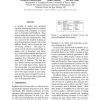Free Online Productivity Tools
i2Speak
i2Symbol
i2OCR
iTex2Img
iWeb2Print
iWeb2Shot
i2Type
iPdf2Split
iPdf2Merge
i2Bopomofo
i2Arabic
i2Style
i2Image
i2PDF
iLatex2Rtf
Sci2ools
ACL
2009
2009
A Comparative Study on Generalization of Semantic Roles in FrameNet
A number of studies have presented machine-learning approaches to semantic role labeling with availability of corpora such as FrameNet and PropBank. These corpora define the semantic roles of predicates for each frame independently. Thus, it is crucial for the machine-learning approach to generalize semantic roles across different frames, and to increase the size of training instances. This paper explores several criteria for generalizing semantic roles in FrameNet: role hierarchy, human-understandable descriptors of roles, semantic types of filler phrases, and mappings from FrameNet roles to thematic roles of VerbNet. We also propose feature functions that naturally combine and weight these criteria, based on the training data. The experimental result of the role classification shows 19.16% and 7.42% improvements in error reduction rate and macro-averaged F1 score, respectively. We also provide in-depth analyses of the proposed criteria.
| Added | 16 Feb 2011 |
| Updated | 16 Feb 2011 |
| Type | Journal |
| Year | 2009 |
| Where | ACL |
| Authors | Yuichiro Matsubayashi, Naoaki Okazaki, Jun-ichi Tsujii |
Comments (0)

